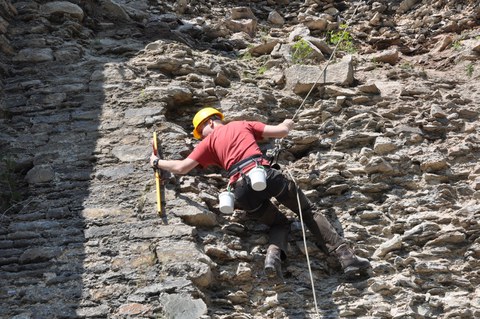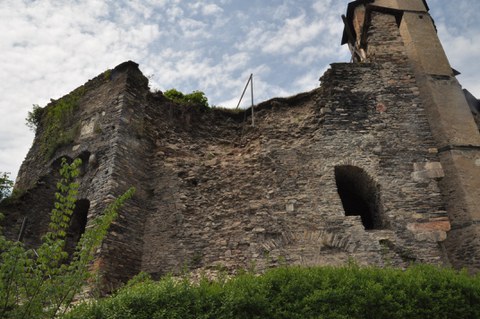Geotechnics of historical buildings
Not only for newly built structures or earthworks, the structure foundation and the bearing capacity stability of the building must be tested and proven. Even for structures which have been existing for hundreds of years, inspections of the supporting formwork and foundation system are ocassionally necessary - especially when the surcharges change, the structure was founded on an unstable ground or the foundation is affected by external influences (changes in groundwater level, floods, plant growth, etc.).

Investigation of the building structur after a partial collapse of masonry
In order to be able to carry out restoration measures, subsoil investigations, the knowledge of surcharges as well as, if possible, a reappraisal of previously performed construction measures are necessary.
At the castle Wespenstein in Thuringia, a castle wall partially collapsed in November 2010. For decades the wall, located in the inner area of the castle, served as a retaining wall for an above situated large-scale plateau.

Castle wall after the collapse
Even before the collapse, deformations in the masonry were observed. With the help of photographic material a wall inclination of approx. 9.5° was determined. Pictures from previous theses also pointed to larger cracks, frost wedging and damaged joints in the wall as well as burst wall segments. In addition, plant growth on the masonry was observed, which indicated moisture penetration. Furthermore, in 1988 it was known that trees with a height of 16m were felled, which stood on the plateau above.
In order to determine the cause of the collapse, field and laboratory tests were carried out to classify the backfill material behind the retaining wall. Furthermore, the shear strengths of the backfill material, as well as the masonry and bricks had to be determined. The backfill material and masonry were classified as a shale whose properties are strongly dependent on the orientation.
Using earth pressure calculations and calculations to determine the compression stress in the masonry, the cause of the collapse of the castle wall can be traced back to a continuous failure process. On the one hand, the increasing root pressure by the tall trees caused deformations in the masonry. On the other hand, water accumulated behind the masonry due to a lack of drainage. An additional loading due to water pressure arose. As a result, the deformations increased and the computational serviceability of the wall was not guaranteed any more. Also, tree felling could not prevent increasing deformations. At a wall inclination of approx. 5° the tilting security was no longer given. With further deformation, the compressive strength of the masonry was exceeded and led to cracks and further burst wall segments. This gradual weakening was the reason for the collapse of the castle wall. The trigger for the collapse is likely to have been the rainy November in 2010, which has led to an increase in water pressure behind the castle wall.
Due to the increasingly recurring extreme weather events that are associated with climate change, residential buildings but also historic buildings are more often exposed to the risk of flooding. The resulting damage to the cultural heritage had inspired the interdisciplinary international cooperative research project, which dealt with the preservation of monuments in relation to flood protection.
The CHEF (Cultural Heritage Protection against Flooding)-project identified the multiple flood events, classified damage to cultural heritage and proposed possible flood protection. This approach was presented on several examples: the Castle Park Pillnitz, the historic old towns of Prague, Regensburg and Grimma and the medieval stone bridge in Písek. The problem of flood protection and monument preservation was examined from various perspectives, such as material science, hydraulic engineering, soil mechanics and engineering geology as well as conservation of historical monuments.
One focus of the Institute of Geotechnical Engineering was the identification of changes in soil behaviour due to flood events. The resulting influences and possible damage to historic buildings were classified from a geotechnical point of view. Furthermore, possible geotechnical construction measures for flood protection were presented by means of numerous case studies. During a flood event, the effects of water on soil play a key role as they are influencing the interaction between soil and building foundation. Due to a flood event, not only damage to the monument but also the destruction of the entire building can be a consequence.
